 TaylorMade Golf has released their 2009 golf lineup and it’s a doozy. Boasting some pretty snazzy technology and giving you enough options to make your head spin, TaylorMade has something to offer to every level of golfer from the high-handicap duffer to the gearhead who tweaks his clubs after every round.
TaylorMade Golf has released their 2009 golf lineup and it’s a doozy. Boasting some pretty snazzy technology and giving you enough options to make your head spin, TaylorMade has something to offer to every level of golfer from the high-handicap duffer to the gearhead who tweaks his clubs after every round.
Yes, we quite frequently poke fun at the folks at TaylorMade for releasing a new driver every other week, but once in awhile they release some equipment that causes you to stop what your doing and pay attention. And they have some of that with this new lineup. How good is it? Ask Pat Perez who won the Bob Hope over the weekend with the R9 driver in his bag. So join me as we see the latest and greatest from the folks at TaylorMade.
R9 Driver
We’ve come a long way since the days since the r7. With the R9, you now have what TaylorMade calls Flight Control Technology (FCT), which by using a wrench, you can change the face angle, loft angle and lie angle. Customization is a wonderful thing.
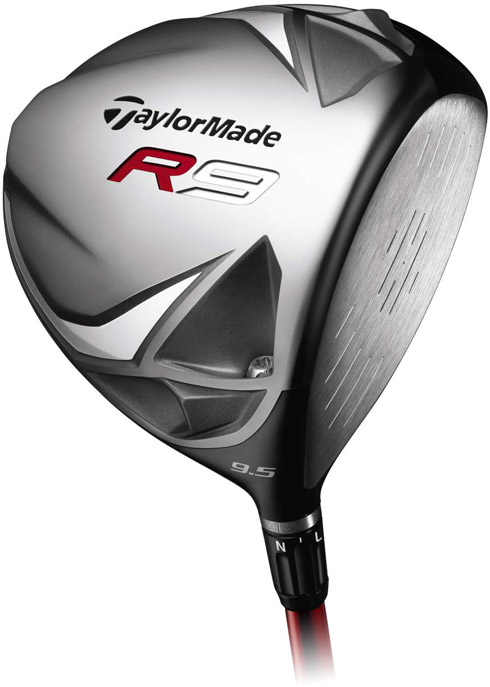
How does this newfangled technology work? Well, there is a a small metallic sleeve positioned over the tip of the shaft. The shaft is then secured to the clubhead with a specially made bolt in the bottom of the clubhead which was “designed to be retained in the well to eliminate the chance of losing it”, which is a great since you now that would be the first thing golfers will lose (or quite possibly the wrench).
The FCT sleeve is made from 7075-T6 aluminum alloy and is “ringed around the bottom with small teeth, which tightly mesh with a second ring of matching teeth within the hosel.” You can change the clubhead’s face angle, loft angle and lie angle just by loosening the FCT bolt, removing the shaft from the head, rotate the sleeve and shaft into the specific position you desire then lock them into that position within the head with the FCT bolt. So easy, even a club pro can do it! (We kid…)
Prior to this, in order to change the face, loft, and lie angles you would have the hosel bent by someone who knows what they are doing and unless you knew the guys in the Tour vans, that could be a hit and miss proposition. Now you can do the same thing without the worry about potential damage to your club. Information overload, here I come.
For those of you who have previously used the r7 line with the Moveable Weight Technology (MWT), the R9 is no different in this regard. The clubhead has three weight ports and comes with one 16-gram and two 1-gram weights. Put the heavy weight in the heel port to give you a draw, the toe port to give you a fade, and in the middle port for straight flight. According to TaylorMade, with all the various clubhead characteristics settings and weight configurations, you have up to “75 yards of side-to-side trajectory change”, otherwise known as the fairway to the right and left of the one you are playing.
The new wrench can be used with both the FCT bolt and the movable weights and is designed specifically for the R9 as the bolt requires 40 inch-pounds of torque to tighten fully (older MWT wrenches deliver only 30 inch-pounds of torque). Just like the older wrenches, the R9 wrench “click” when either the FCT bolt or MWT weights have been tightened.
The R9 driver has a new clubhead shape that combines the shape of the r7 SuperQuad with the r7 Limited, which is a more triangular shape with “beautifully contoured corners.” According to TaylorMade, “the triangular shape offers four distinct advantages:
- It allows for a deep back, far-from-the-face CG location that makes it easier to launch the ball.
- It contributes to a higher MOI for greater stability on off-center hits.
- It allows for an exceptionally low CG location that’s lower than that of the r7 Limited and the r7 SuperQuad.
- It works more efficiently with MWT, allowing it to use only three ports and cartridges to more effectively influence trajectory than the r7 SuperQuad could with four.”
In addition, the R9 utitlizes TaylorMade’s “Ultra-Thin Wall (UTW) technology” which allows the clubhead walls to be be a scant 0.6 millimeters thus allowing more weight to be moved for the Moveable Weight Technology and a lower and deeper center of gravity to be possible. Less weight equals more speed.
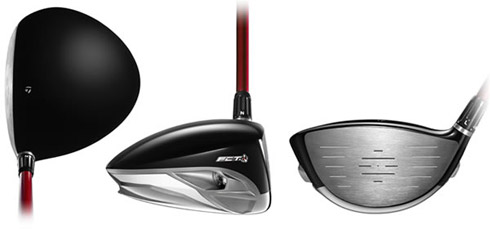
Toss in the old reliable Inverted Cone Technology and you get a clubface that has an expanded area that serves up higher ball speed. Higher moment-of-inertia, lower center-of-gravity and the Inverted Cone Technology gives you a much more forgiving driver. I for one will gladly take some extra forgiveness, thank you very much.
The shaft for the standard version is a Fujikura Motore graphite shaft with High Inertia Tip (H.I.T.) technology (kudos to the marketing folks for that one). The 65-gram shaft has an advanced tip construction to help promote a faster ball speed. The R9 TP comes with a Fujikura Motore F1 65-gram shaft with H.I.T. engineered to be slightly stiffer and with lower torque.
The R9 driver will be offered in 8.5°, 9.5°, and 10.5°degree lofts for righties and 9.5° and 10.5° for lefties in X, S, R and M shaft flexes. The MSRP is a cool $500 (about $400 street), while the R9 TP comes in 8.5°, 9.5°, and 10.5° lofts for righties and 9.5° and 10.5° for lefties in X, S, and R shaft flexes. The MSRP is $600 (about $500 street), and you can pick up either one of these bad boys starting on March 20, 2009, which is conveniently around my birthday. Thank you TaylorMade!
R9 Fairway Woods
The R9 fairway woods incorporate the same FCT technology as the drivers so we won’t spend much time going over the details again. Rather than 75 yards of side-to-side trajectory change, the R9 fairway wood gives you 35 yards.
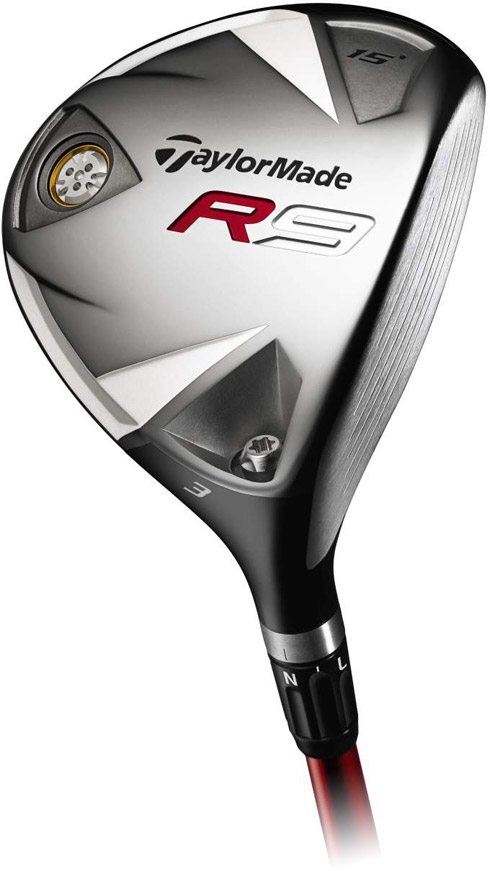
The R9 fairway wood’s clubhead features the same “new classic” shape as the R9 driver in order to give you “a clubhead that’s particularly easy to aim and which sets up cleanly and beautifully behind the ball at address.” It looks quite inviting.
The center-of-gravity location is “more than 50 percent lower than the similarly sized r7 fairway woods” which make the R9 fairways easier to launch than their predecessor. The new classic shape also gives you a higher moment-of-inertia for more stability on those pesky off-center hits and the underside of the head has a more rounded and beveled sole design than previous TaylorMade metalwoods which reduces the amount of sole surface that comes into contact with the turf. Less of chance for you to lay out the sod. Doesn’t get any better than that.
The R9 fairways come with a 70-gram Fujikura Motore graphite shaft in X, S and R shafts for both righties and lefties with loft options including a Tour 3-wood (13°), 3-wood (15°), 4-wood (17°), and 5-wood (19°) and carry a MSRP of $275 per club (about $230 street).
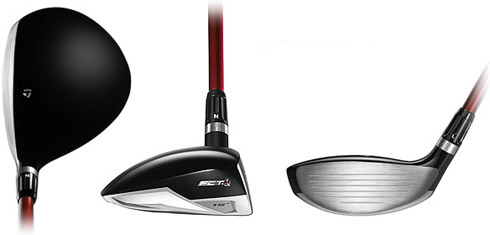
The R9 TP version comes with a “more advanced, tour-caliber” 85-gram Fujikura Motore F1. Loft options include a Tour 3-wood (13°), 3-wood (15°), 4-wood (17°), and 5-wood (19°) in X, S and R shafts for both righties and lefties and will carry an MSPR of $360 (about $300 street) per club. Both versions are available on March 20th.
Rescue 2009
The Rescue 2009 is a throwback in a way as the clubhead size is similar to the original Rescue Mid as opposed to the over-sized hybrids being put on the market today. The Rescue 2009 boasts a “two-tiered, monochromatic crown and silver clubface” which is huge improvement in my opinion over the Rescue Mid’s appearance.
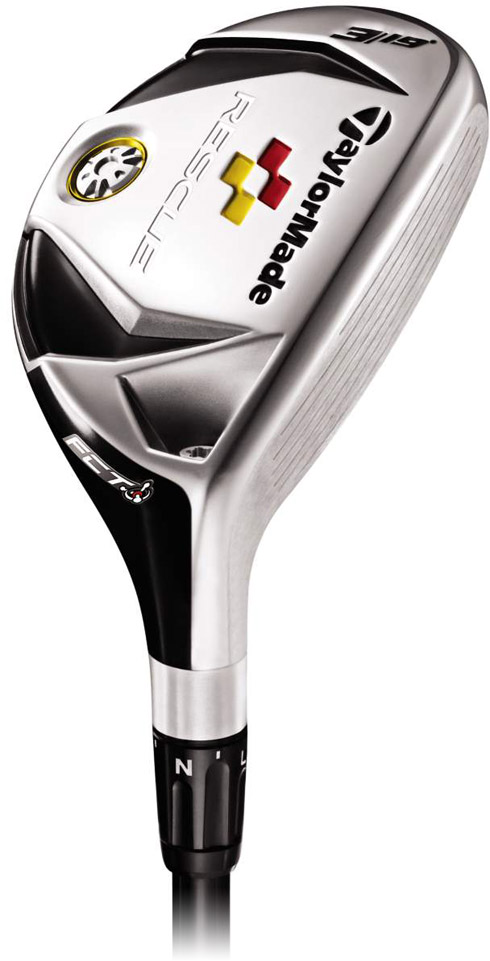
A crown decal is “strategically positioned” in order to make alignment easier so that your clubface is positioned properly to your target-line, thus helping out with your accuracy (although you still have to make the swing).
The Rescue hybrid’s size, while similar to the original Rescue Mid, also boasts UTW technology in the crown, so weight is saved and moved in order to lower the center-of-gravity location.
The sole has been redesigned and has recessed areas in the toe and heel to lessen turf interaction and reduce twisting or slowing down clubhead speed. Any time you have less of chance to chunk one is a good bit of design.
The Rescue 2009 comes in two flavors, the standard Rescue and the Rescue TP with the big difference being that the Rescue TP hybrid has the same Flight Control Technology (FCT) technology that’s in the R9 driver and fairway woods, while the standard Rescue hybrid does not. For those who like to tweak their clubs, the TP version might be for you.
The Rescue TP hybrid comes with the Aldila Voodoo VS8 graphite shaft with S-core technology, which has an internal carbon-fiber rib system to stabilize the shaft’s cross-section. According to Aldila, “S-core technology increases the Voodoo’s hoop stiffness by 80% compared to conventional graphite shafts, allowing the Voodoo to better resist ovaling and deformation during the swing, which in turn maximizes energy transfer to the ball to promote increased distance.” This allows the shaft to be constant throughout the swing which leads to greater consistently in order to square the clubface to the ball with more regularity and giving you
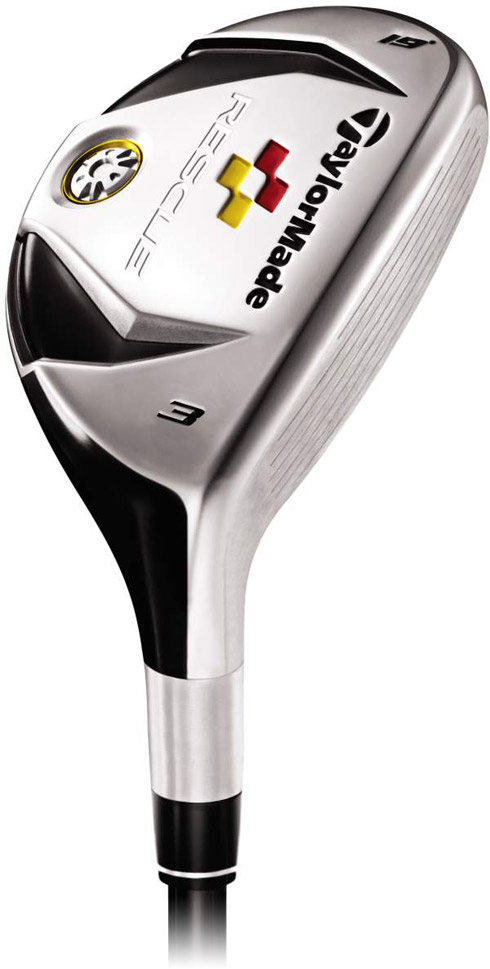
The Rescue TP comes in X, S, and R flexes. More options abound as the Rescue TP hybrid is also available in two custom shaft options, the Fujikura Motore 85 graphite hybrid shaft and the Matrix Ozik Altus Hybrid graphite shaft; both in X, S and R flexes.
The standard Rescue hybrid comes with an Aldila RE*AX 65-gram graphite shaft and in S, R, and M flexes is offered in 2-wood (17°), 3-wood (19°), 4-wood (22°), and 5-wood (25°) for righties and 3-wood (19°), 4-wood (22°), and 5-wood (25°) for lefties. The Rescue TP hybrid is offered in 2-wood (17°), 3-wood (19°), and 4-wood (22°) for righties and lefties. Both become available on May 1st. The Rescue hybrid will carry a MSRP of $199 (street of about $160) while the TP version carries a MSRP of $249 with a street price of about $200.and it becomes available at retail on May 1st.
Burner 2009 Irons
The Burner 2009 irons were designed with blending more forgiveness and giving you more distance in mind. The long-irons, middle-irons and short-irons were all designed separately by the TaylorMade’s “iron-creation team” who started with the 4-iron with the goal to make it forgiving and long. They accomplished this by thinning the clubface as much as possible to make it more flexible and faster for a higher coefficient of restitution.
Custom 450 stainless steel alloy was used for added strength, allowing 1.9 mm thickness across most of the face. Inverted Cone Technology was used in the back of the clubface to in order to increase ball-speed on those pesky off-center hits. The clubhead is increased in sized by expanding the perimeter which increases the moment-of-inertia “to a higher level than any previous TaylorMade iron.”
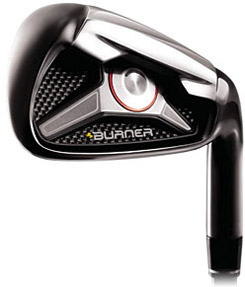 The width of the sole was increased as well in order to get the center-of-gravity lower and farther away for the clubface. The offset was increased as well in order to make it a bit easier to square the face at impact. The top line is thicker to give you the appearance of more mass behind the ball at address which should help give you more confidence.
The width of the sole was increased as well in order to get the center-of-gravity lower and farther away for the clubface. The offset was increased as well in order to make it a bit easier to square the face at impact. The top line is thicker to give you the appearance of more mass behind the ball at address which should help give you more confidence.
The mid-irons and the short irons are a bit smaller in size in comparison to the long-irons but share many of the same design characteristics. The mid-irons boast a slightly thinner topline and sole than the long irons while the short irons have a slightly thinner topline and sole than the mid-irons.
Taylormade’s SuperFast Technology “now incorporates progressive coefficient of restitution, progressive moment-of-inertia, and progressive shaft-length, starting with the short-irons up through the long-irons” as well as ultra-light shafts and grips.” All of this gives you faster ball speed and more forgiveness as you progress from a lot of loft like found in the shorter irons to a little loft such as found in the longer irons and is important to having the longer irons give you the type of ball flight and distance that they’re intended to.
While there are distinctive differences in the Burner 2009 irons, they do share many of the same design elements. The first is each iron has a “multi-functional” sole with beveled edges and consistent thickness.
Another element is the Inverted Cone Technology which is located in the back of each Burner’s cavity, expanding the size of the clubface area that delivers the high ball speed. This gives you more distance on off-center hits which in turns gives you a much more consistent distance from shot to shot.
Like the rest of TaylorMade’s iron lineup as of late, a sound-managing cavity badge is positioned in the back cavity which “utilizes a multi-layer construction composed of carbon composite, aluminum and ABS polymer” and is affixed to the back of the clubface with a thin visco-elastic layer which TaylorMade claims “gives you a softer sound and vibration of impact to promote the kind of soft feel that forged irons are known for delivering.”
The Burner 2009 irons come available in full sets that include 4-iron through attack wedge. You can add a 3-iron, sand wedge and lob wedge to your set as you desire as well. All the clubs are offered for righties and lefties except the lob wedge is only available for righites (no love for you lefties).
The MSRP for a set with steel shafts is $840 with a street price of about $700 while the MSRP for a set with graphite shafts is $1,080 with a street price of about $900. The MSRP for individual clubs is $105 (street about $90) with steel shaft and $135 (street about $113) with graphite shaft. Flexes are available in S and R in steel and S, R and M in graphite. You can add the Burner 2009 to your bag on March 20th.
In Conclusion
Okay, I want the R9 driver, fairway wood, and the Rescue TP. Enough said. My last four drivers have been TaylorMade with the last two being the r7 and the r7 460 TP. I don’t mess around the weights that much in the past but the ability to further tweak my clubs to fit my goofy swing characteristics on my own is very exciting. My only concern with all the options is that I might screw around with settings myself rather than having the settings set for my under the watchful eye of my instructor.
Nonetheless, this is an exciting lineup and March can’t get here fast enough to get these into my hands. Hopefully,this will also be the last driver TaylorMade releases for awhile as well.
Woods look interesting but not at those prices! Maybe in a few years via eBay….
How much can you vary the loft and face angle on these clubs? Can you convert a 9.5 Driver to a 10.0 or even a 10.5, or just to approximately a 9.6? Can you tell the exact loft you have inserted, or just the approximate adjustment (e.g. 2 “notches” increased loft)? Face 1* Open (or Closed), 2*, 3*? Convert a 3 FW into a 3 1/2 FW, or 4 FW (ever since hearing that A Sorenstam used a “strong 4-W, I’ve thought how great that would be, and if I purchased the 3-W could I convert it to a 3 1/2 or 3 3/4 — Strong 4-W)? Convert a 3 TP Rescue into a 3 1/2 Rescue or 4 Rescue?
It is difficult to get overly excited about anything that Taylor Made comes out with these days. By the time you buy one of their drivers, it becomes obsolete as a newer driver is on the way. Although the concept of the R9 driver is interesting, the price tag isn’t. That alone will keep me on the sidelines for some time to come.
Will you actually be reviewing any of these or just the press releases.
This is some great technology but for the price is it really worth the money…are there any incentives for like longer or straighter drives? I already have a burner and im thinking ill pass especially if its not going to help my game
Can you get customized shafts? It sounds like it is similar to the Callaway system where you can buy shafts for the i-mix.
I agree with Mist mountain. Way over priced and the golf Bus does not seem to realise there is a depression on!
well dats tayloremade they just keep the inovation alive!keep up the gd work others “envy”
Does anyone actually have a review of the Burner Irons and what TM is trying to do? Everywhere I go all I get is the data from the website reworded back in some different fashion.
I am truly stuck…I am trying to decide between TM Burner 2009 Irons, Mizuno MX200 and Callaway X22s and I cannot find an honest website for comparison. Any help?
How can you change the lie angle by changing the shaft rotation? Having a hard time visualizing this possibility.
The shaft and hosel are intentionally mis-aligned, like they have a little kink in them. So the hosel part mates squarely to the clubhead, but since the hosel/shaft has a kink, the lie angle and/or clubface squareness changes as the hosel rotates.
Picked up my set of TM Burner 2009 irons last week at Golftown. They had arrived about 1-2 weeks before the planned release date. Hit them several times over the course of the week and compared them to the Ping G10, Nike V, and Callaway X22. There was no comparison – the Burners simply felt smoother to swing, crisper off the club face and a little longer (5-7 yards with a 7 iron). This is I suspect due to about a 2-3 degree lower launch angle which is a result in part to the lower lofts. As well the 85 g shafts were lighter giving me a couple of additional MPH on the swing speed as compared to the other sets – again a bit more distance.
Took them for a trip out to the range today. Very nice. Consistent, quite workable with a piercing ball flight. The clubs were noticeably lighter in the store by comparison but was quickly adapted to on the range. I no longer remember what my old irons felt like. I hit the whole set and did not notice any abnormal feel from a larger offset on the longer clubs or longer shafts.
Although I haven’t had them on the course yet – they are worth a look if you are shopping for new irons.
I tried the 2008 Tour Burner irons for a few months but traded them in when the 2009 Burner irons came out. I noticed a BIG difference in my accuracy with more distance and a great feel. These clubs are worth keeping and worth every penny.
I currently switch back and forth from the Mizuno MP33 and MP60 but decided to look for something a bit more forgiving. (It’s an age thing, not a swing thing). Anyway, I tried the newer Mizunos, the X22s and the Burner. The Burner had a standard head with +1″ on the shaft. It was more consistent and felt much better than the others I tried. Center hits carried 10yds farther. I also preferred the look at setup. Also tried the R9 (compared to my Ping G10) and loved the feel. A very solid club!
Just recently picked up the R9 driver and a set of the ’09 Burner irons. The R9 is the best Taylormade head that I have hit, and I’ve hit and/or owned most all of them. I didn’t think TM could top the ’07 Burner TP which I’ve played for a couple of years now, but I believe they have. The R9 is longer and with all of the adjustability, you can’t go wrong. The stock shaft is not that good however in my opinion. I reshafted with a Diamana Whiteboard that I already had, and the combo is really nice. There really is nothing to reshafting into the new sleeve according to my club fitter which is nice as well. The only drawback to reshafting is you might lose your spine if you change the settings on the driver – that is if you believe that spining really makes any difference.
The new Burner irons are a great set of irons. I thought they were maybe overhyped, but I must say that I was impressed. I spent a couple of hours at the PGA Superstore in Plano,TX and gave them the nod over Titleist AP2’s, Idea A4’s, Ping I10’s, Callaway X22 Tours, and TM Tour Preferreds. I play Adams Idea Pro Golds now and was looking to pick up more distance and forgiveness. Even though the Burners are considered more of a game improvement iron than the others, the feel is pretty close and distance is noticeably better – about a club longer. You’re probably giving up some workability but I’ll take more GIR’s over workability any day. Your mis-hits aren’t nearly as punished as with most all of the players irons. The clubs are about a 1/2 or 1/4 inch longer than most to accommodate the 85 gram steel shaft which takes a little getting used to, but not a lot. The price point on these irons is great as well – $699 for a 4-GW in steel. Highly recommend giving these a look.
I read that on the R9 if you adjust the face to be more closed to help reduce your fade/slice, the loft angle increases. while the opposite, if you open the face to increase the fade/slice, this will reduce the loft angle.
I am currently using a driver with a 10 degree loft and i have a slight to moderate fade.. or often times can be called a slice. 😥
if I were to get a R9 and adjust the face to be more closed, I am wondering if I would need to get the 9.5 or maybe even the 8.5 loft to compensate for the face closing/loft angle increase..
not sure if that made any sense..
just traded my Mizuno Mx 900 irons for these….. and here is why………
Hit them in the net at the golf store and 1st shot with 6 iron went 192 and 5 iron 212 yds…… straight… were much longer and better feel than the g10 ping irons…………..
Bought the 4-pw and sw…….. with reg. flex steel………. awesome clubs…….. easy to hit…….. high launch…….. max carry…… only thing is they are very forgiving but seem hard to work around trees……. but for the extra accuracy and distance are well worth the price………. had them less than a month……… and especially notice on the par 3s where I used to bogey…….. I now get a legitimate birdie opportunity………
I definitely see these irons as being rated super high this year……. mishits still go a good distance and stay on line much better than you would think…………
the clubs are not that much this year… good job taylormade
I am looking at the same clubs. I play with Callaway’s now, but the X-22 I think I’ve ruled out because they just look so fat at address. I’m beginning not to like that the more I look at them. The Mizuno’s were so smooth to hit, but not sure how good they will improve my game. Golf store guy pitched me heavy on 09 Burner’s, repeating everything I’ve read in ads. I am getting fitted for new clubs this week before a vacation and still haven’t decided on Mizuno 200 and 09 Burner. I am definitely looking for more game improvement irons, something to stick with for awhile. Everyone I know that plays Mizunos swears by them.
Any one else have advice?
i agree that the x-22s need a diet..
I previously used 08 Tour Burner irons.. I liked the new dark metal look of 09 Burners.. So i tried them out at the Taylor Made MATT store.. For me, there wasn’t any significant difference in distance or accuracy between the 08 Tour Burners and 09 Burners.. so i didn’t upgrade..
but I did finally upgrade into the Mizuno MX-200s..(5-PW) I got them fitted at the mizuno store.. got them with NS1050(R) shafts, shortened just a tad and got the heads with 1* flatter lie..
i am pretty happy about that.. the main difference is moving away from a cast head into forged.. the benefits might not seem obvious at first.. but the more that I am using the MX-200s, the more that i feel that they are helping me improve..
hard to describe, but hitting with a forged club, it gives you feedback on what you are doing.. while using my Tour Burners, i never felt that i had any feeling after i hit them.. It was more like “smack”.. hmmm.. i wonder where this one is going..but man watch it fly!
with the MX-200s, now it is more like “click”.. ah.. that one is going towards the right..need to adjust a little.. as soon as hit it, you know.. and i think that is important to feel as you improve your game.
a good hit with a cast club has that nice “smack” sound.. where a forged will give you more of a “click” sound.. that is a bit weird at first, but definitely a sound that you’ll like more and more as you hear it.. 🙂
lastly, my opinion, but if you are currently using a cast, game improvement iron.. to me, there is no benefit if you buy another cast, game improvement iron.. best to just keep what you got now.
but if you feel that you have “outgrown” your clubs and are looking for something that can take you to the next step in your game, then you need to go forged.. understandably, forged blades are a big step up and probably not for most people.. but a good forged cavity back.. is a good next step.
ah.. btw, i think i have turned into a bit of a Mizuno fanboy.. i also picked up the Mizuno MX-700 driver.. I am really liking that too.. I tried the R9 driver too.. for me the MX-700 was much straighter.. good thing for me because i’ve been really fighting a fade/slice..
once I settle down with the new driver and irons, i need to decide if I am going to get the 4 iron.. or one of the new MX-700 utility clubs to fill the gap.
I play with an inherited set of X-12’s. I don’t play very often, a dozen times a year or so, but can finally afford to upgrade to the clubs I want. BUT want them to last me for years+++ (not like the driver I change almost every year). I shoot in the mid/high 90’s. My game has gotten better as I’ve upgraded every other club, no finally the irons, which currently I have little confidence in. I don’t know about feel really, how to shape a shot, I mean, but I do know when I hit the Mizunos center I almost felt nothing. I couldn’t even feel I hit it. I loved it, then thought, is that good, or could I be hitting it all over the place but just loving the smoothness?
Quick question, if I may? Will The Sandtrap be reviewing the Rescue 09? Thank you!
Yes, Dave will.
I just picked up the 2009 Burner Irons at Golfsmith – I tried out the X22s, some forged mizuno version, titleist ap1s and the Burners.
I’m about an 11, and expect to be down in the single digits by end of summer.
I don’t know why, but I just hit the Burners better. I actually went to the store thinking of buying the X22s or a forged iron.
The distance is further, I’m guessing it’s a combination of loft & the clubs being longer.
I’m pretty standard/regular height/weight guy, but for some reason slightly longer clubs do the trick for me (I also play the G10 driver).
I hope I made the right choice, but I’m sure they’ll be an upgrade over the TM Firesoles I’ve been playing for 10 years!
All of my tests were with a 6-iron.
I’ve build my own clubs for years,but this year I decided to buy
set of 09 burners. The shafts are reg.flex. ball flight way to high and and I have to use more club for length. I’ve had them for a month may need more time to adjust. Lesson learned don,t believe all the hype.
I am looking for more forgiving irons. How much is too much? Your review of the Callaway fusion wide soles was excellent and sparked my interest. A few golf shops still have sets at great buys. I also like the new 09 burner irons. I currently play mizuno mx-25 irons and my percent of flush shots is just not high enough. Any info. would be appreciated. Thanks!
Started playing the Burner ’09 irons this summer. They are very good clubs for a couple of reasons. First, with the light weight and large footprint, the club inspires confidence over the ball and is easy to swing smoothly. When you hit it flush, the ball jumps off the face of the club, and for me is a club longer than my previous irons – Titleist CB 775 forged. When you don’t hit it perfectly, there is lots of forgiveness in these irons. Mishits still end up OK – good not great – most of the time. I agree that when you hit a forged iron flush the feedback is fantastic, but the point is that as a mid-handicapper that simply doesn’t happen all the time. The added forgiveness of the Burner irons has definitely helped my game. I hit my irons more consistently and have added some distance.
Can the lie of my RAC OS irons be bent to change the angle to one degree flatter, even though they have graphite shafts? At the present time, the toe is sticking up at this approximate degree.
I had been using ping irons that had a red dot, which I presume is one degree flat. I would appreciate it very much if you can help me with this problem. Thank you for your time in this matter.